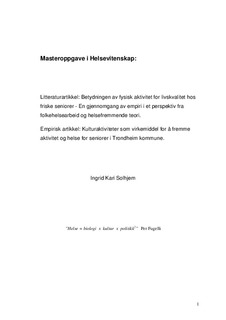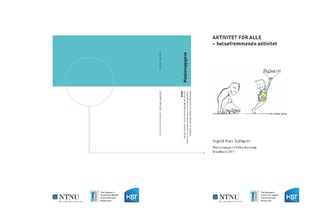| dc.contributor.advisor | Espnes, Geir Arild | nb_NO |
| dc.contributor.author | Solhjem, Ingrid Kari | nb_NO |
| dc.date.accessioned | 2014-12-19T14:34:05Z | |
| dc.date.available | 2014-12-19T14:34:05Z | |
| dc.date.created | 2012-04-18 | nb_NO |
| dc.date.issued | 2011 | nb_NO |
| dc.identifier | 516354 | nb_NO |
| dc.identifier.uri | http://hdl.handle.net/11250/267844 | |
| dc.description.abstract | Et samfunnsvitenskaplig perspektiv i oppgaven er å ha fokus på samspill mellom samfunn, kultur og individ. Samfunnet behøver å legge til rette for helsefremmende adferd slik at dette blir et naturlig valg. Masteroppgaven er knyttet opp mot et prosjekt som ledes fra Senter for Helsefremmende forskning. Hovedprosjektets tema er ” Kulturdeltakelse og Helse”. Formålet med litteraturartikkelen er å se på fysisk aktivitet i et perspektiv fra folkehelsearbeid og helsefremmende teori, som et teoretisk rammeverk for den empiriske oppgaven. Befolkningsintervensjoner for å fremme fysisk aktivitet er et nytt og spennende tema, og det meste av litteraturen eksisterer fra 2000 og frem til i dag. Fokus i den empiriske artikkelen er å evaluere aktivitet i tilknytning til Den Kulturelle Spaserstokken [DKSS] i Trondheim kommune, hvor en ser på sammenhengen mellom kulturaktivitet og helse. Målgruppen for DKSS er seniorer i aldersgruppen 55 år eller eldre, og generelt sier en at både forskning og tilbud i mindre grad omfatter denne aldersgruppen. Den Kulturelle Spaserstokken kan betegnes som et annerledes og mindre tradisjonelt tilbud for å fremme aktivitet og helse, og fysisk aktivitet er en del av dette. En velger fysisk aktivitet som tema i forbindelse med litteraturartikkelen, fordi det er gjennomført lite forskning som har beskrevet kultur- og fritidsaktiviteter som helsefremmende virkemiddel. | nb_NO |
| dc.description.abstract | The main purpose of this article is to identify literature concerning community intervention, specifically to identify publications which explain how to promote physical activity in the healthy elderly. It is an attempt to extend the perspective of involvement in leisure time physical activity. The main question is if physical activity improves quality of life in the elderly? Literature search was accomplished by a computer or by a manual search (tracking citations), and following key words were used: Physical activity, health promotion, aging/elderly, supporting environment, community interv ention, Quality of life, psychological wellbeing and review. The first part of this article will focus on conceptualization of health promotion and quality of life. The second part will focus on physical activity in public health and the community. The third part focuses on community interventions, physical activity and environmental factors, and their definitions. Physical activity is important to health. The health care system understands how to use drugs to reduce pain and the risk for serious events caused by sedentary lifestyle, but methods to promote physical activity are less well understood. Studies in public health interventions suggest that environmental factors are essential to promote physical activity, and the literature research shows that daily activity improves a overall term of quality of life in the healthy elderly. There is some evidence for a strategy in community interventions to focus on environmental factors to promote more physical activity or positive health behaviours. Interventions for promoting physical activity have mainly focused on physical activity and disease prevention, and strategies have not focused, or have not succeeded in increasing the activity level in the general public. New implementation strategies of physical activity are needed. An ecological approach is one suggestion and a possibl theoretical model for this kind of intervention. In addition the conceptualisation of health promotion also includes a broader perspective of activity and public health. A population-wide approach and health promotion need more attention and further improvements in future research. | nb_NO |
| dc.description.abstract | The health promotion perspective, a focus on health and resources, and an ecological theoretical model have been proposed as a paradigm for the present study. Cultural participation has been used both in governmental health policies and as medical therapy. This is based on the assumpti n that cultural participation will improve health and Quality of Life [QoL]. Adapting this framework the present study evaluates cultural activity participation in a group of healthy elderly. Few studies have included leisure-time physical activity in the concept of culture. The aim of this study is to analyze the relation between cultural activity and health. Data on cultural activities both receptive and creative, and quality of life were collected using a questionnaire. The questions were based on a comprehensive questionnaire from The Nord Trøndelag Health Study (2006 - 2008) and SF-36. The municip lity of Trondheim offers a broad range of varied cultural activities for their seniors. Our study sample was 110 healthy elderly people participating in creative cultural activities on a weekly basis in Trondheim. The response rate in the study was 55 %. The multiple regression analyses show that participation in receptive and creative cultural activities was not significantly associated with quality of life after adjustment for relevant cofactors. Nevertheless both error bars in the independent t-test and scatter plot in the regression analyses show that more activities are associated with increased QoL. QoL is measured as an overall term of physical health (SF-36). The population was homogenous and the effect size is small and therefore the power in the study is too week to detect changes. Compared with a normal population the sample was a group of healthy elderly, and they are overall more active in various cultural activities. An increasing number of cultural activities are also associated with more regular physical activity. Physical activity shows a more significant prediction for QoL than cu tural activities. These results do not support the hypotheses on the effect of cultural activities. The conclusions that can be drawn so far about cultural activity and QoL are limited. A population based study among healthy elderly requires a larger sample. Further research is needed: Epidemiological studies analyzing association: Sufficient statistical power is needed. Longitudinal studies and experimental studies analyzing the question on causality. Qualitative studies for analyzing a deeper understanding. Experimental studies for cultural activities or leisure acitivities. | nb_NO |
| dc.language | nor | nb_NO |
| dc.publisher | Norges teknisk-naturvitenskapelige universitet, Fakultet for samfunnsvitenskap og teknologiledelse, Institutt for sosialt arbeid og helsevitenskap | nb_NO |
| dc.subject | Social and Behavioural Science, Law | en_GB |
| dc.subject | aktivitet | no_NO |
| dc.subject | helsefremming | no_NO |
| dc.subject | forlkehelse kultur | no_NO |
| dc.title | Aktivitet for alle - helsefremmende aktivitet | nb_NO |
| dc.type | Master thesis | nb_NO |
| dc.source.pagenumber | 75 | nb_NO |
| dc.contributor.department | Norges teknisk-naturvitenskapelige universitet, Fakultet for samfunnsvitenskap og teknologiledelse, Institutt for sosialt arbeid og helsevitenskap | nb_NO |

